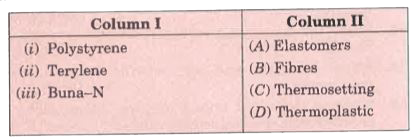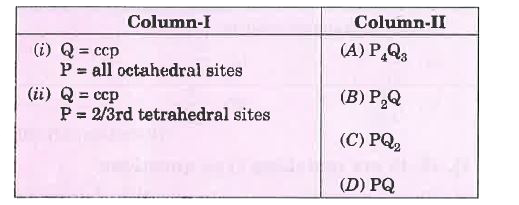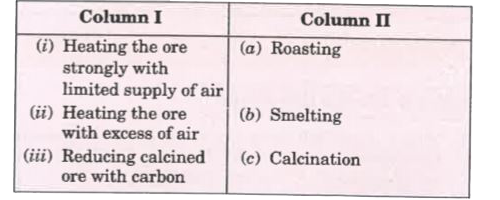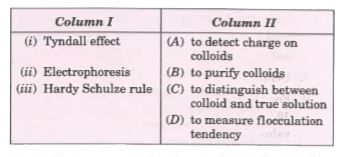Match the close packed arrangment (column I) with its empty space (column II)

A
(i) - (C) - (ii) - (D)
B
(i) - (B) , (ii) - (D)
C
(i) - (C) , (ii) - (B)
D
(i) - (A), (ii) - (B)
Video Solution
Text Solution
The correct Answer is:A
|
Answer
Step by step video, text & image solution for Match the close packed arrangment (column I) with its empty space (column II) by Chemistry experts to help you in doubts & scoring excellent marks in Class 12 exams.
Updated on:21/07/2023
Topper's Solved these Questions
- BOOK - MODERN PUBLICATIONCHAPTER - SOLID STATEEXERCISE - REVISION EXERCISES (OBJECTIVE QUESTIONS) (PASSAGE BASED QUESTIONS)10videos
SOLID STATE
- BOOK - MODERN PUBLICATIONCHAPTER - SOLID STATEEXERCISE - REVISION EXERCISES (OBJECTIVE QUESTIONS) (ASSERTION REASON QUESTIONS)10videos
SOLID STATE
- BOOK - MODERN PUBLICATIONCHAPTER - SOLID STATEEXERCISE - REVISION EXERCISES (OBJECTIVE QUESTIONS) (MULTIPLE CHOICE QUESTIONS)39videos
SOLID STATE
- BOOK - MODERN PUBLICATIONCHAPTER - POLYMERSEXERCISE - Competition file (OBJECTIVE TYPE QUESTIONS) (C. MULTIPLE CHOICE QUESTIONS)(Integer Type Questions)6videos
POLYMERS
- BOOK - MODERN PUBLICATIONCHAPTER - SOLUTIONSEXERCISE - UNIT PRACTICE TEST14videos
SOLUTIONS
Similar Questions
Knowledge Check
- Question 1 - Select One
Match the detergent (column I) with its type (column II) .
 A(i) - (A) , (ii) - (B)B(i) - (C) , (ii) - (B)C(i) - (D), (iii) - (B)D(i) - (A) , (ii) - (C)
A(i) - (A) , (ii) - (B)B(i) - (C) , (ii) - (B)C(i) - (D), (iii) - (B)D(i) - (A) , (ii) - (C) - Question 2 - Select One
Match the polymer (column I) with its type (column II)
 A(i)−(D),(ii)−(A),(iii)−(B)B(i)−(A),(ii)−(D),(iii)−(C)C(i)−(D),(ii)−(B),(iii)−(A)D(i)−(D),(ii)−(A),(iii)−(C)
A(i)−(D),(ii)−(A),(iii)−(B)B(i)−(A),(ii)−(D),(iii)−(C)C(i)−(D),(ii)−(B),(iii)−(A)D(i)−(D),(ii)−(A),(iii)−(C) - Question 3 - Select One
Match the method (column I) with its example (column II)
 A(i)-(C) , (ii)-(A)B(i)-(C), (ii)-(B)C(i)-(A) , (ii)-(B)D(i)-(B), (ii)-(A)
A(i)-(C) , (ii)-(A)B(i)-(C), (ii)-(B)C(i)-(A) , (ii)-(B)D(i)-(B), (ii)-(A)
Match the class drug (column I) with its example (column II).
 View Solution
View SolutionMatch the polymer (column I) with its important use (column II)
 View Solution
View SolutionMatch the impurity doped semiconductor (column I) with its type (column II)
 View Solution
View SolutionMatch the arrangment of P and Q (column I) with its formula (column II)
 View Solution
View SolutionMatch the process (column I) with its name (column II)
 View Solution
View Solution



